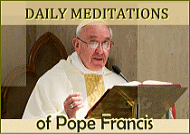Readings: Zeph 3: 14-18/ Is 12: 2-6/ Gal 4: 4-7/ Lk 1: 39-56
“MY SOUL PROCLAIMS THE GREATNESS OF THE LORD.”
A Priest once while traveling by train, was not wanting to enter into any conversation with passengers. To do this he started reading his prayer book and avoiding any eye contact with his fellow passenger across him. The man opposite him wanted to strike a conversation, but could not. All of a sudden with a strong gush of wind that entered the compartment, a picture (of our Blessed Mother) from his prayer book fell down. The co passenger immediately picked it up and took it an opportunity to strike a conversation. While handing it over to the priest, the man asked him whose picture is it? Now the priest who did not want to enter into a dialogue and more still to explain the person of Mary, to cut short all conversation he said that it was the picture of his Mother.
The passenger looked deep into the picture of Mary and took a look at the priest face for a long time; and then said to the priest but you do not look like your Mother!
We celebrate the feast of Our Lady of Arabia, our Mother and Patroness of our Vicariate. We pray through her, we have heard much about Her, have offered up flowers and various token of our love, we carry her image and even have one in our homes. Can others at home and in society looking at us, say, we look like her?
I am sure we do look like her in some way or another. However, what more can we do to look like her?
– Be humble
– Be attentive to the prompting of the spirit
– Be focused on all that we do, and to see the hand of God in it.
– Keep all that happens within us and out of us, pondering in our heart.
– Prayer and meditate on the Word of God
– To carry Jesus with us daily and to give Him to others.
– Being available to those in need
– To do the Lord’s will
– Renew our YES always
– To always search for Jesus and to find Him.
The feast of Our Lady of Arabia is our feast too, for those who belong to AVONA, the reason being is that we find in our Blessed Mother what she went through in her life:
– Lady of the Desert
– The flight into Egypt
– The isolation
– Rejection
– Migration
– Poverty
– Insecurity, to name a few
We do experience all the above and much more, like Mary as we too are in the same situation out here in a land that is not our own, but we can surely say, in a better situation as Mary. However, Mary along with Joseph with Jesus underwent these and in much difficult situation than ours (even to the extent of being killed). Yet she took all these in her stride and above all contemplating these events in her heart.
Finally, the gospel of today (Magnificat), we find three movements in the hymn of praise and thanksgiving, that we can make our very own.
a. The present of the personal experience. In the Bible, expressions of thanksgiving always flow from an actual, personal experience of salvation. Heads of people, war heroes, prophets, and psalmists recount, each in a personal way, their wonder over God’s active presence at the center of history and the center of human life.
The entire first half of the Magnificat (1:46-50) tends to express the unique experience of Mary from the moment that the conception of Jesus was announced. Mary “proclaims the greatness of the Lord” because she realizes it is He Who is active here and now at the core of her life. She gives thanks for being favored by the God Who “has looked with favor on His lowly servant” and Who, for her, “has done great things.” The God whom she extols is the same One Who has intervened so many times in behalf of His people.
b. An experience open to the future. Turning her attention to the future (“all generations will call me blessed”), Mary focuses on the absolute newness and the normative character of the Incarnation. Henceforth, it is the Incarnation that will reveal, more than any other sign or marvel of God, the holiness of His Name and His mercy…in every generation.
This also tells the realism and profundity of the Incarnation. It has to be received anew “in every generation”, in the period of history that is ours, between the Resurrection of Christ and His Parousia, period of the Church’s apostolate.
c. From yesterday to today. The second part of the Magnificat (1:51-55) shows the equilibrium and the depth of Mary’s faith. Far from thinking only of herself, she expands the horizon of her thanksgiving to include the whole people of God and its history.
Likewise, as humble servant, she can more easily reflect on the habitual ways of God and discover His preferences for the poor and lowly in the Psalmic sense.
Wishing each one of you a very Happy Feast of Our Lady of Arabia.
Fr. Franco Pereira, S.D.B.


